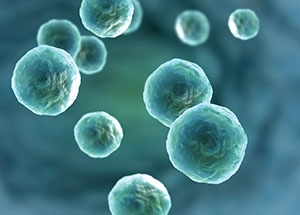Cystic Fibrosis Is Two Diseases; One Doesn’t Affect Lungs, Study Suggests

Cystic fibrosis could be considered two diseases, one that affects multiple organs including the lungs, and one that doesn’t affect the lungs at all, according to a multicenter team led by researchers at the University of Pittsburgh School of Medicine. The research, published online in PLOS Genetics, showed that nine variants in the gene associated with cystic fibrosis can lead to pancreatitis, sinusitis, and male infertility, but leave the lungs unharmed.
People with cystic fibrosis inherit from each parent a severely mutated copy of a gene called CFTR. The healthy gene makes a protein that forms a channel for the movement of chloride molecules in and out of cells that produce sweat, mucus, tears, semen, and digestive enzymes, said co-senior investigator David Whitcomb, chief of gastroenterology, hepatology, and nutrition, Pitt School of Medicine. Mutations in the gene can lead to dysfunctional CFTR channels and thick, sticky secretions, causing problems such as the chronic lung congestion associated with cystic fibrosis.
with cystic fibrosis inherit from each parent a severely mutated copy of a gene called CFTR. The healthy gene makes a protein that forms a channel for the movement of chloride molecules in and out of cells that produce sweat, mucus, tears, semen, and digestive enzymes, said co-senior investigator David Whitcomb, chief of gastroenterology, hepatology, and nutrition, Pitt School of Medicine. Mutations in the gene can lead to dysfunctional CFTR channels and thick, sticky secretions, causing problems such as the chronic lung congestion associated with cystic fibrosis.
Previously in cystic fibrosis research, other kinds of mutations of CFTR were deemed harmless because they didn’t cause lung problems, Whitcomb noted, but the Pitt-led study looked more closely at that notion. “We examined whether these variants could be related to disorders of the pancreas and other organs that use CFTR channels.”
Co-senior author Min Goo Lee of Yonsei University College of Medicine in Seoul, Korea, conducted careful tests of CFTR in pancreatic cell models and determined that a molecular switch inside the cell called WINK1 made CFTR channels secrete bicarbonate rather than chloride molecules.
“Pancreas cells use CFTR to secrete bicarbonate to neutralize gastric acids,” Whitcomb said. “When that doesn’t happen, the acids cause the inflammation, cyst formation, and scarring of severe pancreatitis.”
cells use CFTR to secrete bicarbonate to neutralize gastric acids,” Whitcomb said. “When that doesn’t happen, the acids cause the inflammation, cyst formation, and scarring of severe pancreatitis.”
The research team found nine CFTR gene variants associated with pancreatitis after testing nearly 1,000 patients with the disease and a comparable number of healthy volunteers. They also learned that each variant could impair the WINK1 switch to prevent CFTR from becoming a bicarbonate-secreting channel.
Co-senior author Ivet Bahar built a computer model of the CFTR protein’s structure and determined that all nine variants alter the area that forms the bicarbonate transport channel, thus impairing secretion of the molecule. Bahar is a Distinguished Professor and John K. Vries Chair of Computational Biology, Pitt School of Medicine.
“It turns out that CFTR-mediated bicarbonate transport is critical to thin mucus in the sinuses and for proper sperm function,” Whitcomb said. “When we surveyed pancreatitis patients, there was a subset who said they had problems with chronic sinusitis. Of men over 30 who said they had tried to have children and were infertile, nearly all had one of these nine CFTR mutations.”
He added that identification of the mechanisms that cause the conditions make it possible to develop treatments. In addition, the identification will spur the launch of trials to determine if medications used by cystic fibrosis patients might have some benefit for those who do not have lung disease, but who carry the other mutations.
The team includes researchers from the University of Pittsburgh, the Mayo Clinic, Brigham and Women’s Hospital, and many other institutions that are part of the North American Pancreatitis Study Group.
Other Stories From This Issue
On the Freedom Road

Follow a group of Pitt students on the Returning to the Roots of Civil Rights bus tour, a nine-day, 2,300-mile journey crisscrossing five states.
Day 1: The Awakening
Day 2: Deep Impressions
Day 3: Music, Montgomery, and More
Day 4: Looking Back, Looking Forward
Day 5: Learning to Remember
Day 6: The Mountaintop
Day 7: Slavery and Beyond
Day 8: Lessons to Bring Home
Day 9: Final Lessons

